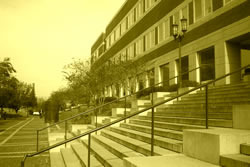|
March 14th: Roland Barthes's
Elements of Semiology
Leading Class Discussion
Let's have our second "Leading Class Discussion" participant come up and see what to make of all this.
I had too much fun over Spring Break and didn't get to finish grading your Mini-Rhetorical Analysis Essays...I'll make up for that by doing something nice tonight.
Barthes's Elements of Semiology
It is easy to get lost trying to follow Barthes's symbols and particular definitions. Also, he gives us a lit review alongside his arguments throughout the book. If I were really wanting us to jump around, I'd ask "How is Barthes allowing for the birth of the reader?" Maybe we should stick to Elements of Semiology and then go to "Death of the Author."
Let's revisit what Barthes has to teach us about rhetoric.
Important terms from Elements of Semiology:
- metalanguge: language about language; second-order language, which does not exist independant from first-order language.
- sign: union of signifier and signified (II.1.2, p. 38)
signified: "a mental representation of the 'thing'" (II.2.1, p. 42)
signifier: relayed by words; sounds, objects, images (II.3.1, p. 47)
- syntagm: analysis of the surface structure of "a combination of signs" (III.1.1, p. 58)
Often you might hear the syntagm is individual words or terms.
- system (or paradigm): "a series of associative fields" (III.3.1, p. 71); classes of similar elements
Language: A Social Practice
But probably not praxis, right? Does Barthes have the goal (in his work) or believe it is possible for the masses to change or reframe or manipulate language? Who speaks the language? Does the individual "I," or does the subject(ed) speak?
Here are some place we might want to focus on:
- Languge is socially constructed (I.1.2, p. 14)
Speech is individual selection (I.1.3, pp. 14-15)
- Speech before language (I.1.4, p. 16)
- Second-order corpus conveying meaning (I.1.6, p. 20)
- Durkheim's collective consciousness (I.2.1, p. 23)
What ideologies do we share?
- "Linguistic 'form' is filled by the free variations and combinations which a speaker needs for a particular message" (I.2.3, p. 28)
Let's think further about his menu metaphor...
- Origins of sygnifying systems: The deciding groups for language (I.2.6, p. 31)
- Language---Finite; Speech---Infinite (I.2.7, p. 33)
- Different readers decipher language differently (II.1.2, p. 38)
But what about the "collective consciousness" and the idea of language being socially constructed?
- "Language is...that which divides reality" (III.2.2, p. 64)
- Commutation test (III.2.4, p.67):
- Signifiers
- Significance
- Create paradigm classes; sets of related, similar terms
- Via Saussure: "Language...can admit no difference between what distinguishes a certain thing and what constitutes a thing" (III.3.1, p. 72)
- Letters and sounds do not identify intermediate states: think about 'b' vs. 'p' (III.3.2, p. 74)
Again, there is much more we could discuss about Barthes, and, in a different context (e.g., with a professor from a different area, such as, linguistics) we might discuss Barthes's work, well, differently. I think it's safe to say that, even though language is socially constructed, it isn't monolithic. Signs convey meaning differently based on context and the individual's socialization and experiences
Now, what can we say about "The Death of the Author"? How about "Death of a Martian"?
Next Week's Reading
Next week (3/21) we'll discuss Nietzsche's Use and Abuse of History and pp. 1-28 from Writings from the Late Notebooks (On Moodle). I should have your presents back to you by next week. |
